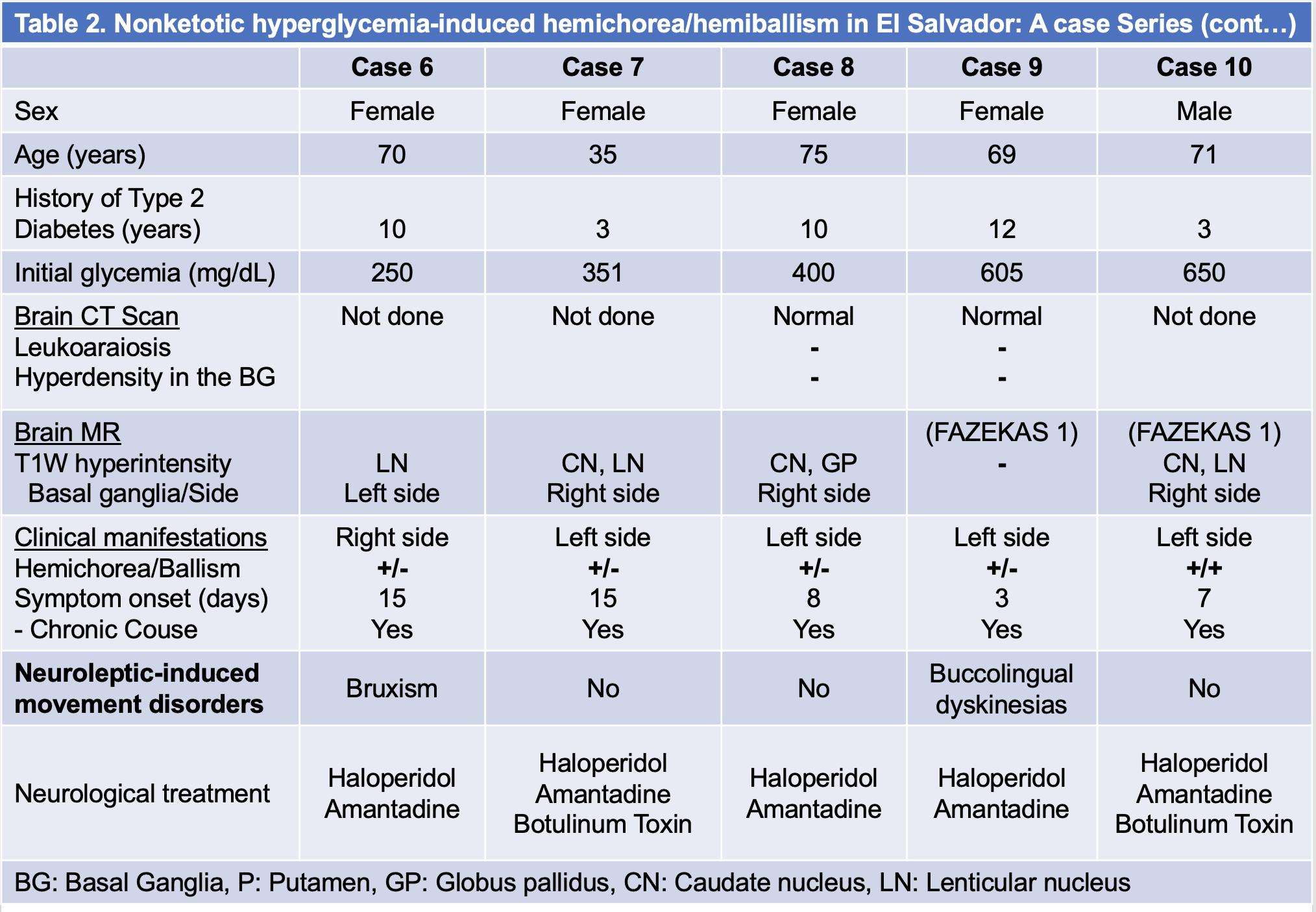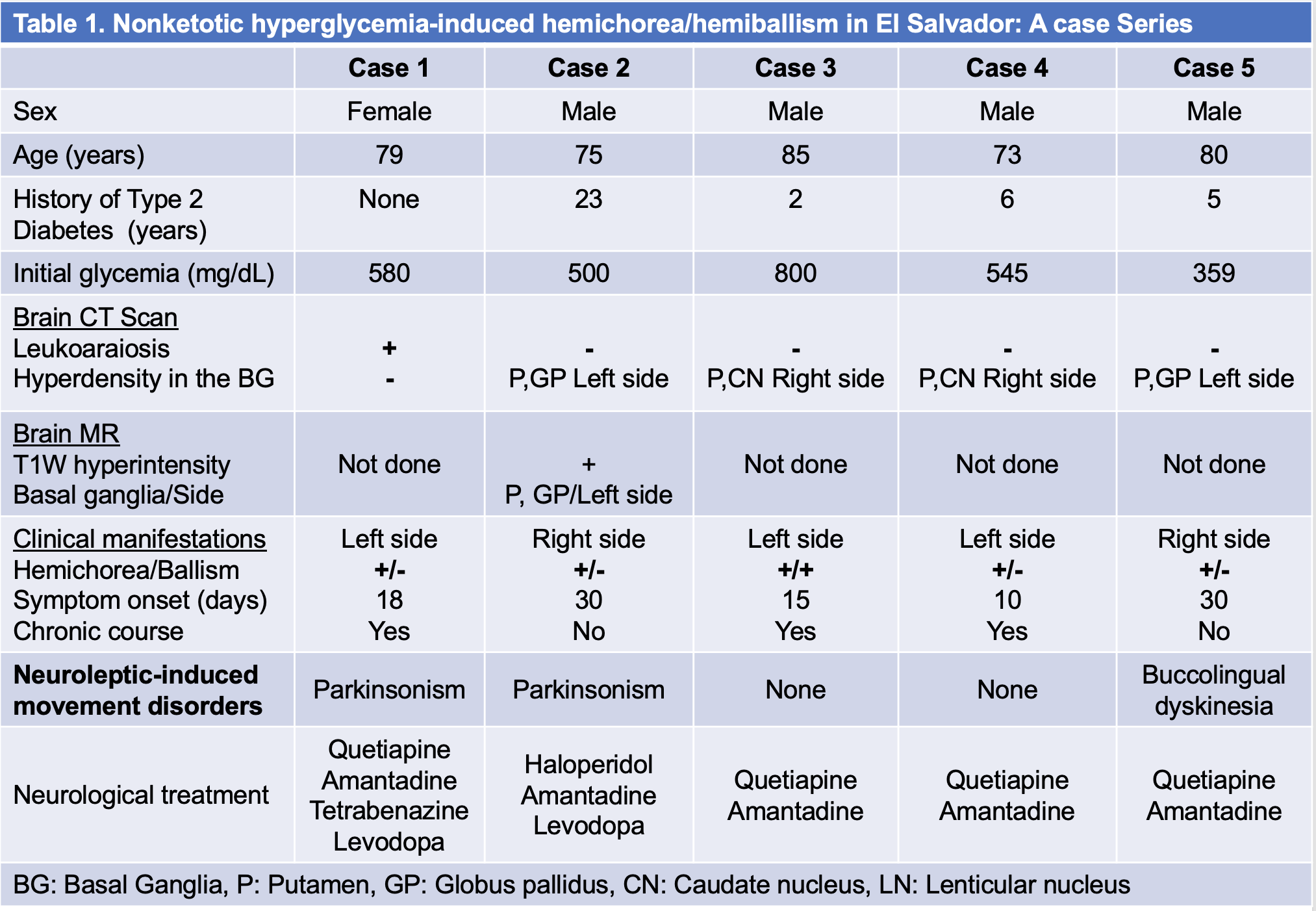Category: Choreas (Non-Huntington's Disease)
Objective: We conducted a retrospective study to investigate the clinical characteristics of patients with nonketotic hyperglycemia-induced hemichorea/hemiballism referred to a movement disorder clinic in El Salvador, Central America.
Background: Hemichorea/Hemiballism is a neurological syndrome characterized by continuous, non-patterned, proximal, involuntary movements on one side of the body, resulting from involvement of the contralateral basal ganglia (1). It can occur in the setting of uncontrolled type 2 diabetes mellitus (DM) and is usually considered to be self-limited, but chronic, long-lasting manifestations have also been reported (2).
Method: We analyzed consecutive adult subjects that developed hemichorea/hemiballism associated with nonketotic hyperglycemia referred to a movement disorder clinic from 2004 to 2022. We obtained demographics, clinical examination, video recording, imaging studies, treatment, and follow-up results.
Results: 10 patients fulfilled the inclusion criteria of hyperglycemia-induced hemichorea/hemiballism (5 female and 5 male), with mean age of 71.2 years (range, 35-85 years), mean glycemia at symptom onset was 504 mg/dl (range 250-800 mg/dl), and mean history of type 2 DM was 13 years (0-23 years). All subjects presented hemichorea and only 2 cases also developed hemiballism. All cases presented contralateral striatal abnormalities in neuroimaging studies. Only 2 subjects presented full remission after correction of hyperglycemia, and 8 subjects had a chronic course (Table 1 and Table 2). All subjects were treated with neuroleptics; 2 subjects developed drug-induced Parkinsonism and 2 tardive dyskinesia (buccolingual).
Conclusion: Hemichorea/hemiballism is a rare complication of nonketogenic hyperglycemia in type 2 diabetes and is associated with contralateral striatal abnormalities on neuroimaging studies. Symptoms can improve with adequate glycemic control, but as most of our cases reported, symptoms may have a chronic evolution.
References: 1. Cosentino C, Torres L, Nuñez Y, Suarez R, Velez M, Flores M. Hemichorea/Hemiballism Associated with Hyperglycemia: Report of 20 Cases. Tremor Other Hyperkinet Mov (N Y). 2016 Jul 19;6:402. doi: 10.7916/D8DN454P. PMID: 27536463; PMCID: PMC4955070.
2. Salem A, Lahmar A. Hemichorea-Hemiballismus Syndrome in Acute Non-ketotic Hyperglycemia. Cureus. 2021 Oct 25;13(10):e19026. doi: 10.7759/cureus.19026. PMID: 34853750; PMCID: PMC8608038.
To cite this abstract in AMA style:
R. Lopez-Castellanos, R. Lopez-Contreras. Nonketotic hyperglycemia-induced hemichorea/hemiballism in El Salvador: A case Series [abstract]. Mov Disord. 2023; 38 (suppl 1). https://www.mdsabstracts.org/abstract/nonketotic-hyperglycemia-induced-hemichorea-hemiballism-in-el-salvador-a-case-series/. Accessed April 17, 2025.« Back to 2023 International Congress
MDS Abstracts - https://www.mdsabstracts.org/abstract/nonketotic-hyperglycemia-induced-hemichorea-hemiballism-in-el-salvador-a-case-series/


